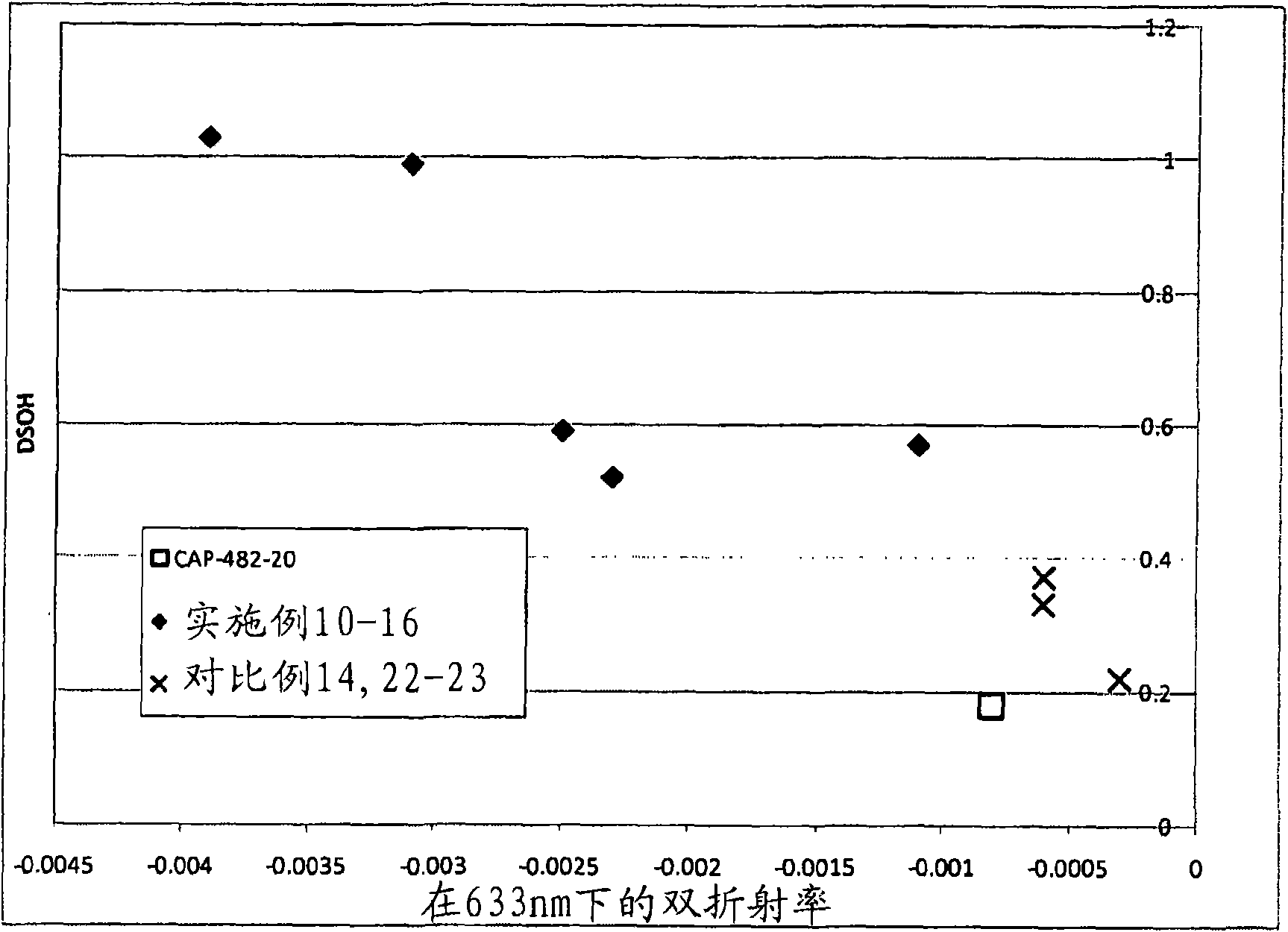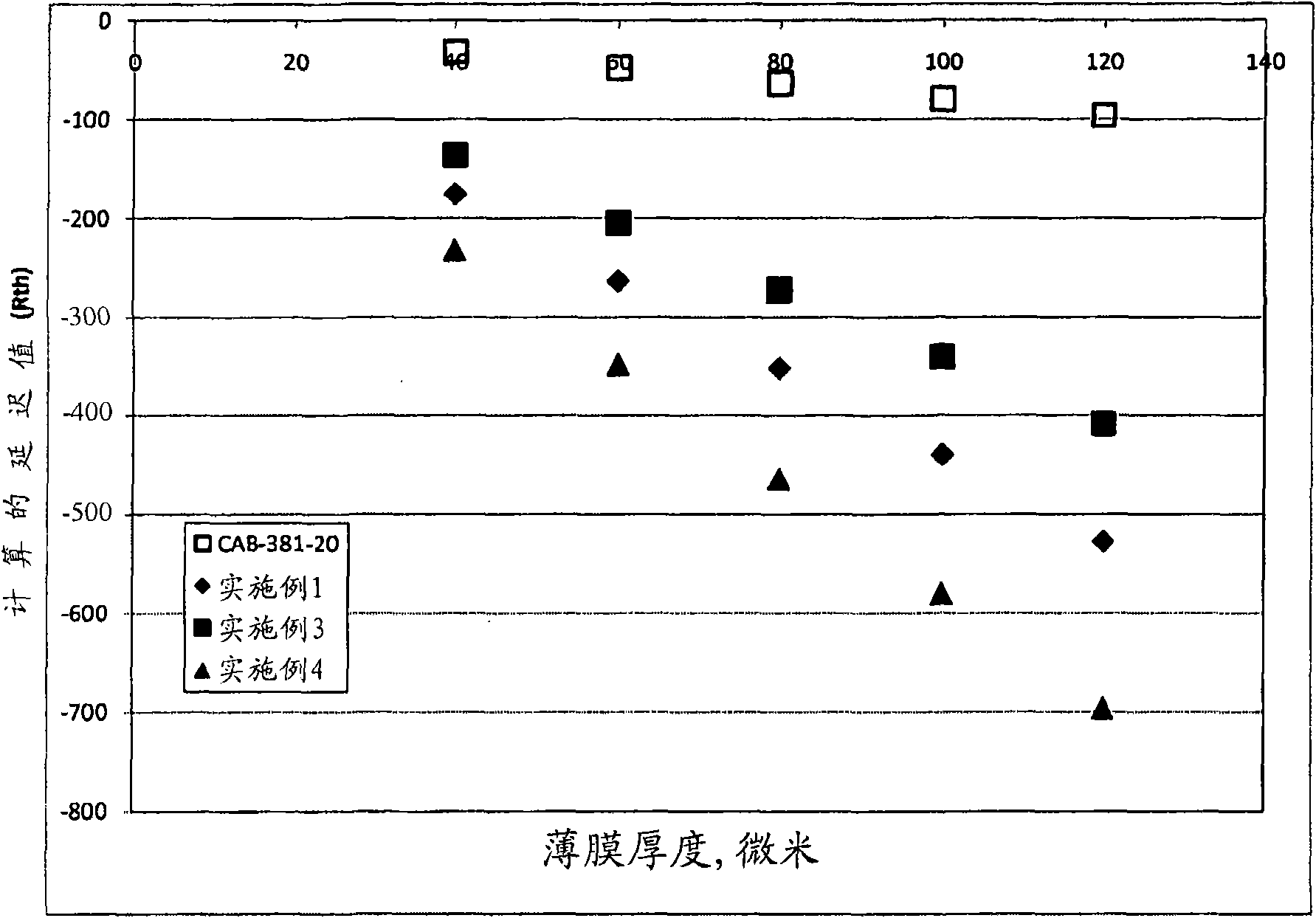Cellulose esters with a high hydroxyl content and their use in liquid crystal displays
A liquid crystal display, cellulose technology, applied in instruments, polarizing elements, optical elements, etc., can solve the problems of yield loss, complex processing steps, etc.
- Summary
- Abstract
- Description
- Claims
- Application Information
AI Technical Summary
Problems solved by technology
Method used
Image
Examples
Embodiment 1-20 and comparative example 21-23
[0320] The cellulose ester dopant was prepared by adding cellulose esters (such as CAB-381-20, CAP-482-20, CAP-141-20, all commercially available from Eastman Chemical Company, Kingsport, Tennessee) to To a suitable reaction vessel (eg, a 1000 mL 3-necked round bottom flask equipped with overhead stirrer and thermocouple and temperature controller) containing a mixture of acetic acid, propionic acid, butyric acid and water. The mixture is stirred and heated to a suitable temperature, typically 40°C to 85°C, until the cellulose ester is dissolved and a clear, viscous mixture results. A catalyst mixture comprising sulfuric acid, butyric acid and / or propionic acid and acetic acid is added to the cellulose ester dope. The hydrolysis mixture comprising butyric acid and / or propionic acid, acetic acid, water and optionally sulfuric acid is added in a suitable manner (for example, dropwise, in portions, in the form of a steady stream, or in a single addition) to Cellulose ester dopan...
Embodiment 13-14
[0335] The CAP adulterant was prepared by dissolving 250 grams (about 319.67 g / mol, 0.78 mol, based on anhydroglucose units, Eastman Chemical Company, batch #BP-04951-B) of CAP-482-20, 1226.6 Grams (20.43 mol) of acetic acid were added to a 5000 ml 3-neck round bottom flask equipped with an overhead stirrer and a thermocouple connected to a J-Kem temperature controller and the mixture was stirred at 55 °C until the solids dissolved into a clear dopant or Slightly cloudy viscous mixture. The blend was allowed to cool to room temperature with stirring overnight. The dope was heated to 70°C and a catalyst solution comprising 253.6 grams (14.07 mol) of demineralized water and 3.775 grams (0.038 mol) of sulfuric acid was added to the CAP dope. A hydrolysis solution comprising 695 grams (11.57 mol) of acetic acid, 695 grams (38.61 mol) of demineralized water was added to the dropping funnel and then added dropwise to the CAP dopant / catalyst solution mixture. Care was taken to add ...
Embodiment 15-16
[0340] The CAP adulterant was prepared by dissolving 250 grams (about 319.67 g / mol, 0.78 mol, based on anhydroglucose units, Eastman Chemical Company, batch #BP-04951-B) of CAP-482-20, 1226.6 Grams (13.92 mol) of butyric acid were added to a 5000 ml 3-neck round bottom flask equipped with an overhead stirrer and a thermocouple connected to a J-Kem temperature controller and the mixture was stirred at 55°C until the solids dissolved into a clear adulterant Or slightly cloudy viscous mixture. The blend was allowed to cool to room temperature with stirring overnight. The dope was heated to 70°C and a catalyst solution comprising 96.4 grams of butyric acid (1.09 mol) and 3.775 grams (0.038 mol) of sulfuric acid was added to the CAP dope. A hydrolysis solution comprising 1200 grams (19.98 mol) of acetic acid, 1200 grams (66.59 mol) of demineralized water was added to the dropping funnel and then added dropwise to the CAP dopant / catalyst solution mixture. Care was taken to add the...
PUM
| Property | Measurement | Unit |
|---|---|---|
| thickness | aaaaa | aaaaa |
| thickness | aaaaa | aaaaa |
| thickness | aaaaa | aaaaa |
Abstract
Description
Claims
Application Information
 Login to View More
Login to View More - R&D
- Intellectual Property
- Life Sciences
- Materials
- Tech Scout
- Unparalleled Data Quality
- Higher Quality Content
- 60% Fewer Hallucinations
Browse by: Latest US Patents, China's latest patents, Technical Efficacy Thesaurus, Application Domain, Technology Topic, Popular Technical Reports.
© 2025 PatSnap. All rights reserved.Legal|Privacy policy|Modern Slavery Act Transparency Statement|Sitemap|About US| Contact US: help@patsnap.com



